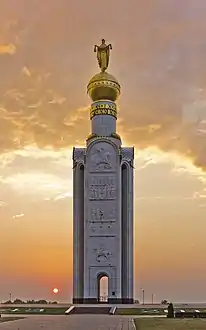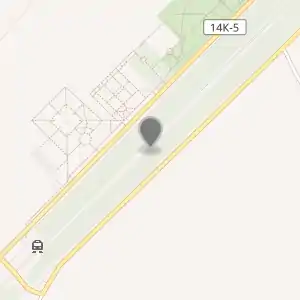معركة بروخوروفكا
معركة بروخوروفكا (بالإنجليزية: Battle of Prokhorovka) هي إحدى معارك الحرب العالمية الثانية بين النازيين والسوفيات , وشكلت جزءاً من معركة كورسك وفيها حدث أكبر اشتباك بالدروع والدبابات خلال التاريخ العسكري حتى أطلق عليها [Clash of the armour] .حيث اشتبكت أكثر من 850 دبابة سوفيتية ضد حوالي 250 دبابة ألمانية . انتصر الألمان في هذه المعركة انتصار تكتيكي مؤقت لكنهم عانوا من كثرة الخسائر وعدم القدرة علي تعويضها (بعكس السوفييت الذين عانوا من خسائر افدح لكنهم امتلكوا احتياطيات كبيرة) ومثلت معركة كورسك بشكل عام بداية النهاية للقوة العسكرية الكبري للألمان على الجبهة الشرقية .
| معركة بروخوروفكا | |||||||
|---|---|---|---|---|---|---|---|
| جزء من معركة كورسك على الجبهة الشرقية | |||||||
 النصب التذكاري لمعركة بروخوروفكا | |||||||
| معلومات عامة | |||||||
| |||||||
| المتحاربون | |||||||
| القادة | |||||||
| |||||||
| القوة | |||||||
| فيلق بانزر إس إس الثاني[upper-alpha 1]
فيلق بانزر الثالث[upper-alpha 2]
|
Steppe Front[upper-alpha 3]
Voronezh Front[upper-alpha 9]
| ||||||
| الخسائر | |||||||
| German: (See Casualties and Losses section for details)
|
Soviet: (See Casualties and Losses section for details)
| ||||||

| |||||||
مراجع
- Clark 2012، صفحة 408، "Even though II SS Panzer Corps could claim to have won a tactical victory in the monumental armoured clash at Prokhorovka... باول هاوسيه men did not do enough to change the course of the operation.".
- Zetterling & Frankson 2000، صفحة 109، "Losses for the Germans were not particularly severe during this period, but added to the losses suffered previously they were not insignificant. No German unit was withdrawn from the front for refitting. On the Soviet side the 2nd Guards Tank Corp was withdrawn to be refitted.".
- The Battle of Kursk: Myths and Reality — Retrieved 04 June 2013 — "While Prokhorovka offered the Germans a tactical victory, operationally it was a death knell for CITADEL" نسخة محفوظة 08 يوليو 2013 على موقع واي باك مشين.
- Zamulin 2011، صفحة 561، "The counterattack did not achieve its basic goal. The enemy [II SS Panzers Corps] was not routed, but the further advance of the II SS Panzers Corps beyond Prokhorovka was finally halted.".
- Overy 1997، صفحة 208, "German losses were too great to allow a decisive breakthrough. Soviet forces held the German attack, but made little progress themselves. Flanking movements by heavy German forces to the left and right were repulsed."
- Zetterling & Frankson 2000، صفحة 108، "If we take a look at how the front lines changed during these five days one could interpret it as some sort of success for the Germans... However, if we compare the outcome with the German orders for the battle, which stated that Prokhorovka was the target, it is clear that the Germans fell short of their goals. The Red Army had hoped to push the II SS Panzer Corps back and crush it. This failed completely, but at least the 5th Guards Tank Army prevented the Germans from taking Prokhorovka.".
- Overy 1997، صفحة 210، "By 15 July both sides had ended up where they started. The SS Divisions were devastated. The فرقة بانزر إس إس توتنكوبف الثالثة which bore the brunt at Prokhorovka was withdrawn from the front.".
- The Battle of Kursk: Myths and Reality — Retrieved 04 June 2013 [وصلة مكسورة] نسخة محفوظة 08 يوليو 2013 على موقع واي باك مشين.
- Clark 2012، صفحة 378.
- Clark 2012، صفحة 398.
- Clark 2012، صفحة 384, 400-401.
- Glantz & House 2004، صفحة 288.
- Glantz & House 2004، صفحة 327.
- Zetterling & Frankson 2000، صفحة 48.
- Glantz & House 2004، صفحة 318.
- Glantz & House 2004، صفحة 321.
- Clark 2012، صفحة 379.
- Zetterling & Frankson 2000، صفحة 101.
- Glantz & House 2004، صفحة 323.
- Glantz & House 2004، صفحة 167.
- Clark 2012، صفحة 230.
- Glantz & House 2004، صفحة 324.
- Clark 2012، صفحة 349.
- Clark 2012، صفحة 230, 399–402.
- Zetterling & Frankson 2000، صفحة 108–109.
- Bauman 1998، صفحة 8-5 to 8-6.
- بوابة ألمانيا
- بوابة ألمانيا النازية
- بوابة الاتحاد السوفيتي
- بوابة الحرب
- بوابة الحرب العالمية الثانية
- بوابة القوات المسلحة الألمانية
- بوابة دبابات
في كومنز صور وملفات عن: معركة بروخوروفكا
- Although on 12 July, only Leibstandarte Adolf Hitler (LAH) was advancing directly on Prokhorovka while the other two divisions dealt with their own confrontations on the flanks of LAH,[8] yet the actions on the flanks were critical for LAH, and subsequently for the outcome of the battle.[9] If Totenkopf and Das Reich could gain the upper hand, that would force the Soviet forces blocking LAH to withdraw or else face encirclement, while their failure would leave any advance by LAH in an exposed salient.[9]
- The III Panzer Corps was able to support the right flank of the II SS Panzer Corps during the late phase of the battle (precisely, during Operation Roland).[10] The vanguard of the III Panzer Corps was about 12 miles south of Prokhorovka on 12 July, however the formation did not link up with the II SS Panzer Corps until 15 July.[11] Regiments, battalions and other smaller formations directly subordinate to the Corps' Headquarters are not listed below.[12]
- All the وحدات عسكرية listed below under the Steppe Front had all been transferred to the control of Voronezh Front by 12 July. The list below shows only formations of the Steppe Front relevant to the battle.
- This formation was transferred from the تشكيل المعركة of the Steppe Front to that of the Voronezh Front on 11 July.[13] All of its subordinate corps as of 12 July are listed below.[14] However, the divisions, regiments and battalions directly subordinate to the Army's Headquarters are not listed below.[13]
- This formation was transferred from the تشكيل المعركة of the 1st Tank Army to that of the 69th Army on 10 July, and then to that of the 5th Guards Tank Army on 11 July.[15]
- This formation was transferred to the تشكيل المعركة of 5th Guards Tank Army on 11 July.[16]
- Two of the formation's four brigades – the 10th, 11th and 12th Guards Mechanized, and the 24th Guards Tank Brigades – were sent south to block the III Panzer Corps, leaving its 10th Guards Mechanized and 24th Guards Tank Brigades at Prokhorovka; hence, the formation did not have a full presence in the battlefield of Prokhorovka.[17][18][16]
- This formation was transferred from the تشكيل المعركة of the Steppe Front to that of the Voronezh Front on 8 July.[19] Only one of its two corps were present in the battlefield of Prokhorovka – that is the 33rd Guards Rifle Corps.[20] The other corps – the 32nd Guards Rifle Corps – was deployed further west, a few miles southeast of Oboyan.[21] The divisions, regiments and other smaller units directly subordinate to the Army's Headquarters are not listed below.[19]
- The list below includes only the Front's formations relevant to the battle.
- This formation was transferred from the تشكيل المعركة of the 5th Guards Army to that of the 1st Tank Army on 8 July.[22] Not all of its sub-units were present in the battlefield of Prokhorovka.[23] It is not uncommon for this formation to be portrayed as part of the 5th Guards Army during the Battle of Prokhorovka, but that is a metachronistic error.
- The 6th Guards Army bore the brunt of the معركة كورسك from the very opening hours of it; therefore, its subordinate corps present at the Battle of Prokhorovka was already depleted.[20]
- This formation had three corps - the 35th Guards, 48th and 49th Rifle Corps - by 6 July. But on 7 July the 49th Rifle Corps was transferred to the control of the 7th Guards Army؛ moreover, there are divisions, regiments and battalions directly subordinate to the 69th Army that are not listed below.[16]
- Although it never fought in the vicinity of Prokhorovka, the 35th Guard Rifle Corps confronted the supportive actions of the III Panzer Corps on the right flank of II SS Panzer Corps during the battle of Prokhorovka (precisely, during Operation Roland).[24]
- These losses are for the II SS Panzer Corps
- These are the maximum possible permanent losses incurred by the II SS Panzer Corps and the III Panzer Corps from 12–16 July according to German archives.[25]
- These losses are for the whole 5th Guards Tank Army.
- This is an estimate for the 69th Army, 5th Guards and 5th Guards Tank Armies
- This does not including self-propelled guns and are just losses incurred by 18th, 29th and 2nd Guards Tank Corps on 12 July according to the KOSAVE II study.[26]
This article is issued from Wikipedia. The text is licensed under Creative Commons - Attribution - Sharealike. Additional terms may apply for the media files.